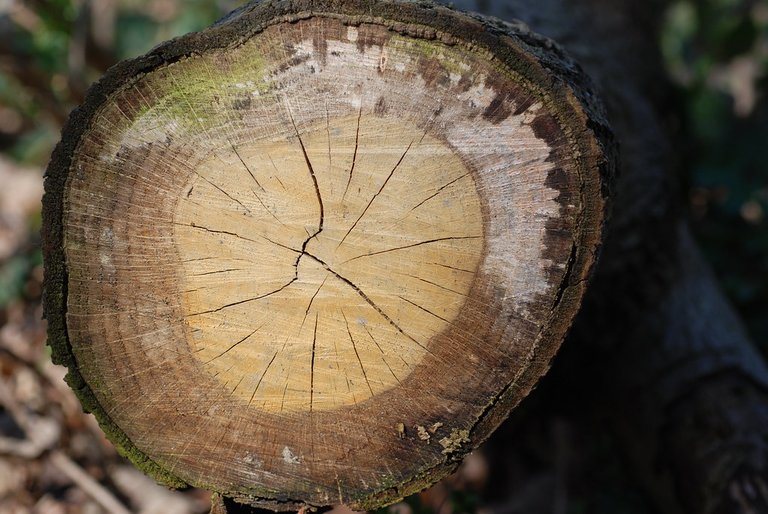If you are asked to divide the kingdom of living things we would mention five of them including fungi, protista, monera, animalia and Plantae, and we all know that these living things have cells which are usually alive but in some case, they can be dead and one division of the kingdom that doesn't mind having a whole lot of dead cells is plants.
Trees contain a large amount of dead tissues just like most higher plants with one tissues known as Xylem and it is important for trees as it is used to transport water and nutrients around the plant and it is made throughout the lifetime of a plant. Xylem are formed when double wall cells die and form a row with their skeleton so it can be used to move minerals and water though out the plant.
Since trees are tall, at some point in their life they discovered a way to transport nutrients and using dead tissue as transporting system from the root to the top and xylem was the best candidate. While being a transport system, it also provided support for the tree. The living cell in a tree is concentrated in the Sapwood which is the outermost part of the tree, while the Heartwood which is formed as the tree grows is compressed and is majorly made up of the xylem which are dead cells. Due to the compressed nature of the heartwood, it is what keeps the tree standing since it is tough and resilient.
As a result of this problem, archeologist finds it difficult to be able to date a tree that existed a long time ago and so gave the phenomenon a name known as the Old wood Effect since it makes their job difficult. Archeologist are people who help us understand how long a particular living creature, fossil, or organic thing has been in existence and they do this accurately using carbon dating. With carbon dating, they consider carbon-12 and carbon-14 which are isotopes of carbon. Carbon-12 has 6 proton and 6 neutron in its nucleus while carbon-14 has 6 protons and 2 extra neutron in its nucleus. Carbon-12 is stable due to its 6 neutrons while carbon-14 isn't stable due to its extra neutron.
Earth has more carbon-14 in the atmosphere and it is usually absorbed by living organisms but stops being absorbed after death after which it begins to decay and interact with other molecules. So in other for Archeologist to identify how long a living being or organic object has existed after a long time, they look at the amount of carbon-14 remaining in the fossil or organic object.
Archeologist now have a problem with wood dating because if they are to use carbon dating, the tree would give an older year more than the actual time it died because it already contained dead tissues before it died. If archeologist are looking to identify what things were used a thousand years ago, they often stumble on charcoal or wood but when they try to carbon date them, the problem arises. If it is a Sapwood, it is still very fair but when it comes to heartwood, it becomes very difficult to identify as it has been dead years before the tree itself died. With this, archeologists try to look for any other organic material around to carbon date if they can find.
For the sake of science, other methods need to be employed. Archeologist have been able to find ways identify and date trees using other techniques like dendrochronology to identify unique tree ring patterns to climate or historical events of the time they existed. So when next you see an archeologist giving a wrong date when it comes to wood or charcoal dating, just blame the Old Wood Effect for it.
Reference
https://arboretum.harvard.edu/stories/unlocking-ancient-environmental
https://bio.libretexts.org/Bookshelves/Botany/Botany
https://www.texasbeyondhistory.net/radiocarbon
https://www.texasbeyondhistory.net/radiocarbon/selectinghttps://www.radiocarbon.com/old-wood-effect.htm
https://www.sciencedirect.com/topics/agricultural-and-biological-sciences/xylem
https://micro.magnet.fsu.edu/trees/glossary.html
https://www.sciencedirect.com/science/article/abs/pii/0305440386900245
https://link.springer.com/article/10.1007/s12520-018-0766-8
https://arboretum.harvard.edu/stories/unlocking-ancient-environmental
https://bio.libretexts.org/Bookshelves/Botany/Botany
https://www.texasbeyondhistory.net/radiocarbon
https://www.texasbeyondhistory.net/radiocarbon/selectinghttps://www.radiocarbon.com/old-wood-effect.htm https://www.sciencedirect.com/topics/agricultural-and-biological-sciences/xylem https://micro.magnet.fsu.edu/trees/glossary.html https://www.sciencedirect.com/science/article/abs/pii/0305440386900245 https://link.springer.com/article/10.1007/s12520-018-0766-8


Curator - GuestVoted through #Ecency.